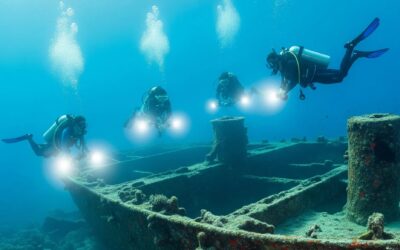The Descent
The descent seems one of the simplest parts of diving. You just deflate your BC, get ready to equalize and the fun starts. But in fact, the descent is very important and should be well managed. The descent as such is the beginning of your immersion. Think about this: If you start already your dive with problems, what can you expect from the rest of your dive? Your dive, your comfort during the dive, your buoyancy… Many factors depend on how you perform your descent. Descending uncontrolled, upside down moving heavily and crashing against the bottom like a rock… This not an option if you want to become a buoyancy master. Let’s have a closer look at these disadvantages:
– The only one that can stop you from sinking is the bottom: You will destroy corals or other marine life on every dive.
– If you don’t descend, you will ask for more weight: Instead of learning how to descend in a controlled manner, you will believe that the problem is that you are underweighted. You will add more load to your gear. You will be diving overweighted. You can’t master your buoyancy overweighted. Read about the buoyancy check.
– You can have serious equalisation issues: Remember that you must descend slowly equalizing every meter. You have to be able to stop or ascend if necessary.
-You can get sick, loose orientation or experience nausea: Due to the increasing pressure in your ears and the loss of reference while rolling upside down or facing the blue, you might get totally disoriented.
– You can easily loose your group: If your group is descending slowly and you sink like a rock, separation is guaranteed. Even more under circumstances like poor visibility or strong currents.
– You waste a huge amount of air: If you struggle descending and you try hard with strong movements, your body is making a big effort. You will get exhausted and breath stronger. Once being out of breath it is difficult to calm yourself down during the dive.Doesn’t sound simple any more, does it?
How to perform a controlled descent?
To be able to perform a controlled descent, focus. The best tip would be to relax, be conscious about what are you doing and what’s better to avoid.
1. Stop Swimming!
Although we float on the surface with a inflated BC, many divers still have the instinct to swim. Swimming heavy at the surface is very exhausting. It is a waste of energy that turns into a heavy breath. If you keep swimming unconsciously while descending, your kicks will bring you back to the surface, instead of descending slowly with the rest of the group. You will believe it is due to the lack of ballast and you will ask for more weight. You will be one of those divers who uses this always-repeated sentence:”Once I am at he bottom I am okay, the only problem is that I need a lot of weight to go down.”Stop swimming, relax and exhale! Soon you will realise that you need much less weight than you thought. Read about The Bad Habit of Overweighting.
To be able to perform a controlled descent, one should focus. The best tip would be to relax, be conscious about what are you doing and what’s better to avoid.
2. Keep a Vertical Position
It is very important to keep a vertical position, feet first, in order to perform a controlled descent. To descend you need to empty the air inside your BC. Therefore it is important to understand that air only goes in one direction, upwards. If you do not stay upright while deflating, you will not be able to completely deflate your BC. This will make it very difficult for you to descend. So before asking for more weight or fighting and swimming to descend, check that you are in a vertical position and that your BC is totally empty. Being vertical will make you less water resistant, making your descent easier. Keeping the vertical position is also important to maintain orientation and eye contact with your buddy.
3. Be Conscious About The Position Of Your Fins
Your fins are a very powerful tool that we use to move underwater. They are designed to displace the maximum amount of water with the minimum amount of energy. It is very important to remember this while descending.If you keep your legs straight but the fins horizontal, you’ll find it more difficult to descend. The reason is your fins are creating water resistance. They slow you down on your way to the bottom. Another effect of maintaining the horizontal fins is that they pull your legs upwards. You will end up face up. At this moment, you have already begun an uncontrolled descent. Bend your knees a bit and make sure your fins are vertical. Imagine you would try to stand on the tips of your toes, like a ballerina.
4. Be Aware Of Your Breathing Pattern
In previous articles we have already gone through the importance of breath control and rhythm. As a general rule, breathing heavy will not help you under any circumstances while diving. Learn more about Breathing and Air Consumption.
5. Establish Neutral Buoyancy
If you follow these advices and you are properly weighted, you should descend slowly to the bottom. But although you descend gently, if you end up crushing against the corals you failed in your attempt. It is very important that you adjust your buoyancy during your way down. Remember that the deeper we go the heavier we become, so don’t wait until the last moment to add air into your BC, do it progressively while descending. If it’s a long descent to greater depth, adjust it a couple of times and take it easy.To perform a controlled descent is not as difficult as it might seem. Concentrate on what you are doing and don’t allow your thoughts to get distracted. As in these buoyancy series, we will deal with one thing at a time. Your next step: The Trim.



